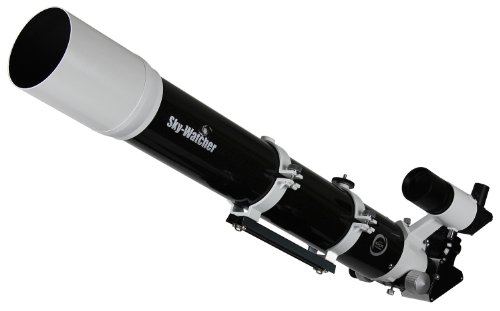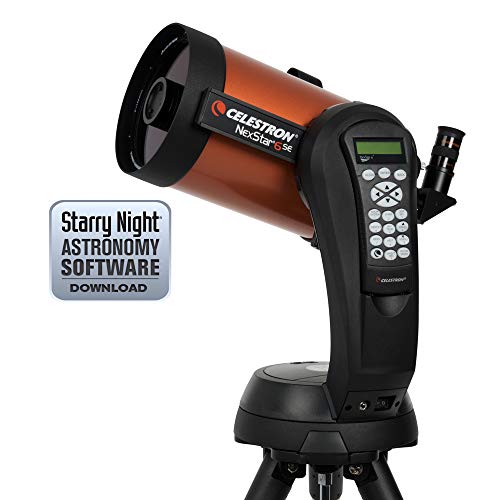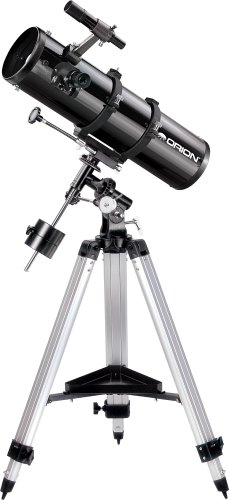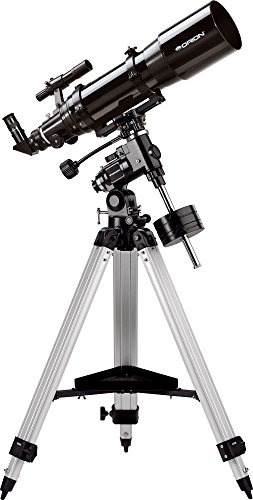7 Best Telescopes Under $1000 in 2025 – Top Picks & Reviews
Last Updated on
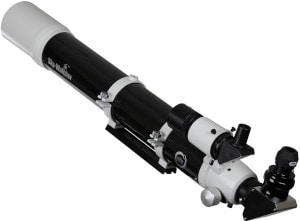
Many people enjoy stargazing and observing the planets. A telescope is needed to get the best view, and there are a ton of them out there to choose from. They are expensive, though, so how do you get one if you live on a budget?
We reviewed many telescopes that cost under $1000 and have put together a list of seven that we think will give you the most value. We will tell you some of the pros and cons of each one so you can begin to narrow down the field that you have to choose from.

A Rundown of our Favorites in 2025
| Image | Product | Details | ||
|---|---|---|---|---|
| Best Overall |
 |
Sky-Watcher ProED |
|
CHECK PRICE |
 |
Celestron NexStar |
|
CHECK PRICE | |
 |
Sky-Watcher Dobsonian |
|
CHECK PRICE | |
| Best Value |
 |
Orion SpaceProbe 130ST |
|
CHECK PRICE |
 |
Celestron NexStar Computerized |
|
CHECK PRICE |
The 7 Best Telescopes Under $1000
1. Sky-Watcher ProED Refractor Telescope – Best Overall
The Sky-Watcher ProED is a 100mm APO refractor telescope with a 90mm focal length. It includes a dual speed two-inch focuser with an adapter, an 8×50 viewfinder, a two-inch dielectric diagonal, two different-sized eyepieces, and a carrying case.
This is a small telescope that’s easy to take with you wherever you go and provides you with quality images. However, if you’re using a heavy eyepiece, the focuser slips at times, making it more challenging to get a clear view. The case is kind of flimsy. It has good padding on the inside to protect the telescope, but the outside material doesn’t seem like it will hold up very well.
- 100mm APO refractor
- 90mm focal length
- Dual-speed two-inch focuser with adapter
- Two eyepieces
- 8×50 RA viewfinder
- Two-inch dielectric diagonal
- Aluminum carrying case
- Focuser slips with heavy eyepieces
- Flimsy case
2. Celestron NexStar Telescope

The Celestron NexStar 6 SE Telescope features a six-inch aperture and a 59-inch focal length. It comes with SkyAlign technology to help you get your scope aligned correctly, so you can easily find the 40,000+ celestial objects that are preprogrammed into the scope. It’s great that this scope automatically finds things for you because there are no crosshairs to help you find the center of the object you’re observing. All this technology drains the telescope’s battery pretty fast. You may want to consider getting a 110-volt adapter for it if you’ll be using it near an outlet.
This telescope has a steel tripod that breaks down for easy transport with the compact scope. The tripod only has one arm, though, so if you breathe hard or have even the slightest breeze, it will wobble on you. It isn’t a huge deal until you get into the smaller lenses.
- Six-inch aperture
- 1500mm (59-inch) focal length
- SkyAlign technology
- Automatically tracks 40,000+ preprogrammed celestial objects
- Compact
- Steel tripod
- No crosshairs in scope
- Single arm on tripod isn’t steady
- Batteries don’t last long
3. Sky-Watcher Dobsonian Telescope
The Sky-Watcher S11620 Traditional Dobsonian Telescope features a ten-inch aperture with a 1200mm focal length for obtaining a clear view. The telescope is held onto the tripod by a mount with Teflon bearings and a tension clutch. This mount will hold the scope steady, but the telescope itself is quite heavy, and you’ll find that the tripod slowly drifts downward under its weight. You’ll either have to keep readjusting it or get a heavy-duty tripod.
This telescope has a two-inch single speed focuser with a 1.25-inch adapter. It doesn’t have fine-tuning capabilities, though. It also comes with two different-sized eyepieces, 25mm and 10mm.
- Ten-inch aperture
- 1200mm focal length
- Two-inch single-speed focuser with 1.25-inch adapter
- Two eyepieces
- Rocker-mount with Teflon bearings and tension clutch
- No fine tuning
- Heavy
- Tripod drifts down under weight of telescope
4. Orion SpaceProbe 130ST Telescope – Best Value
The Orion 09007 SpaceProbe 130ST Equatorial Reflector Telescope features a 5.1-inch aperture and a 24-inch focal length. Both are pretty small, so you don’t see high-quality images. It comes with a finderscope and two different-sized eyepieces, 25mm and 10mm.
The first problem we encountered with this telescope was the written instructions. They are very confusing and difficult to follow. We recommend using YouTube videos to assemble it. They are much clearer.
We also found that the mount isn’t strong enough to hold this telescope steady. The grips don’t stay secure, and the scope wobbles, making it difficult to see clear images.
- 1-inch aperture
- 24-inch focal length
- Two eyepieces
- Finderscope
- Poorly written assembly instructions
- Poor image quality
- Grips that hold the scope don’t hold well
- Mount is too lightweight for scope
5. Celestron NexStar Computerized Telescope
The Celestron NexStar 127SLT Mak Computerized Telescope has a five-inch (127mm) aperture, a 1500mm focal length, and a finderscope. It also comes with SkyX planetarium software to help you locate specific items in the sky. We do find it difficult to fine-tune images with this telescope.
This telescope isn’t built with the best materials, so it seems to be somewhat fragile. The focuser causes the scope to shake somewhat, and at times it will move the object you’re looking at completely out of view.
The mount that comes with this scope is another reason the telescope is shaky. It’s very lightweight and not strong enough to hold the telescope steady. The tripod that comes with this telescope is not great. It wobbles with a light breeze.
- 5-inch (127mm) aperture
- 1500mm focal length
- Finderscope
- SkyX planetarium software
- Difficult to get fine focus
- Flimsy construction
- Weak mount
- Tripod shakes in light breeze
- Focuser causes shaking
6. Orion AstroView Refractor Telescope
The Orion 9005 AstroView 120ST Equatorial Refractor Telescope has a 4.7-inch (120mm) aperture, a 600mm focal length, a polar alignment scope, and two different-sized eyepieces, 25mm and 10mm.
This telescope is heavy and cumbersome, so taking it places can be difficult. Once you get it set up where you want to view, it’s hard to find the objects you’re looking for unless you know the layout of the sky well, as there is no computer guidance to help you find things. Another thing that makes it difficult to see objects is the axis finder. Its location on the telescope makes it very awkward to use. There is also no auto guide to help you align the telescope to where you want it.
- 7-inch (120mm) aperture
- 600mm focal length
- Polar alignment scope
- Two eyepieces
- Axis finder is awkward to use
- No auto guide to help align
- Heavy and cumbersome
- No computer guidance
7. Orion 8297 Newtonian Astrograph Reflector Telescope
The Orion 8297 8-Inch f/3.9 Newtonian Astrograph Reflector Telescope features an eight-inch aperture and an 800mm focal length. Both of the internal mirrors also come with a protective coating to help keep them from getting damaged.
This is a good telescope for a beginner who can’t afford much, but remember that you get what you pay for. Most of the parts on this telescope are painted a flat black, but the spider vanes are a shiny black, and the focuser is silver. Things reflect off silver, making this a bad choice, but the shiny finish on the spider vanes causes glare too. You also need to be careful with the focuser, because it’s held in place with plastic thumbscrews. When you do finally get your object into focus, there’s no focal lock to keep it in position.
- Eight-inch aperture
- 800mm focal length
- Both mirrors have protective coatings
- Focuser held in place with plastic thumbscrews
- Paint causes glare
- No focal lock

Buying Guide:
Types of Telescopes
1. Refractor:
This telescope has a glass lens at the front and a mirror in the back. Light passes through the lens, into the mirror, and then into the eyepiece. This is the most common type of telescope.
Refracting telescopes have all the optics protected in a sealed tube. They’re simply designed and easy to use. They also require virtually no maintenance.
2. Reflector:
A reflecting telescope has two mirrors in it. The light enters through one end, reflects off the first mirror into the second, and then goes into the eyepiece. They’re compact and lightweight, but they have open tubes that allow dust to collect on the optics. These telescopes will give you much better quality images than refractor types, but they do require some maintenance to keep the optics clean.
3. Compound:
The compound telescope has a mirror at each end and a lens that the light must pass through before it reaches the eyepiece. The optics are protected in a sealed tube and are great when you’re trying to view faint objects. These scopes are usually big and bulky and are more expensive than the other two types.
What kind of telescope is best for me?

What to look for in a telescope:
1. Aperture:
Aperture is the amount of light that gets into your telescope. It’s determined by the diameter of the mirror or lens inside the scope. The amount of light determines how much you can see. As a general rule, the larger the aperture, the better you can see.
2. Focal Length:
The focal length determines how big your objects will look. It’s measured by the distance between the point you’re focusing on and the lens or mirror in your telescope. The longer the focal point is, the bigger your object will appear.
3. Magnification:
The magnification of an object is determined by the focal length and the eyepiece you use. Again, the bigger the number of magnification, the bigger the object will appear. Different eyepieces have different magnification levels. You can start with whatever comes with your telescope and upgrade to a higher magnification later.
Related telescope reads:
- The ultimate guide to Choosing a Telescope You’ll Love
- How To Clean your Telescope
- How Much Does A Good Telescope Cost?

Conclusion
Now that we have explained the different types of telescopes and the most important things to look for when buying one, let us remind you of our favorite 4 scopes from our reviews.
1. Sky-Watcher ProED 100mm Doublet APO Refractor Telescope – Best Overall
2. Celestron NexStar 6 SE Telescope – The Runner-Up
3. Sky-Watcher S11620 Traditional Dobsonian Telescope
4. Orion 09007 SpaceProbe 130ST Equatorial Reflector Telescope – Best Value
Hopefully, you now have enough information to get you headed in the right direction in your shopping spree. Now all that’s left is to decide which one will fit your needs and your budget the best.
Table of Contents
- A Rundown of our Favorites in 2025
- The 7 Best Telescopes Under $1000
- 1. Sky-Watcher ProED Refractor Telescope – Best Overall
- 2. Celestron NexStar Telescope
- 3. Sky-Watcher Dobsonian Telescope
- 4. Orion SpaceProbe 130ST Telescope – Best Value
- 5. Celestron NexStar Computerized Telescope
- 6. Orion AstroView Refractor Telescope
- 7. Orion 8297 Newtonian Astrograph Reflector Telescope
- Buying Guide:
- Conclusion
About the Author Robert Sparks
Robert’s obsession with all things optical started early in life, when his optician father would bring home prototypes for Robert to play with. Nowadays, Robert is dedicated to helping others find the right optics for their needs. His hobbies include astronomy, astrophysics, and model building. Originally from Newark, NJ, he resides in Santa Fe, New Mexico, where the nighttime skies are filled with glittering stars.
Related Articles:
How to Clean a Refractor Telescope: Step-by-Step Guide
How to Clean a Telescope Eyepiece: Step-by-Step Guide
How to Clean a Rifle Scope: 8 Expert Tips
Monocular vs Telescope: Differences Explained (With Pictures)
What Is a Monocular Used For? 8 Common Functions
How to Clean a Telescope Mirror: 8 Expert Tips
Brightfield vs Phase Contrast Microscopy: The Differences Explained
SkyCamHD Drone Review: Pros, Cons, FAQ, & Verdict




